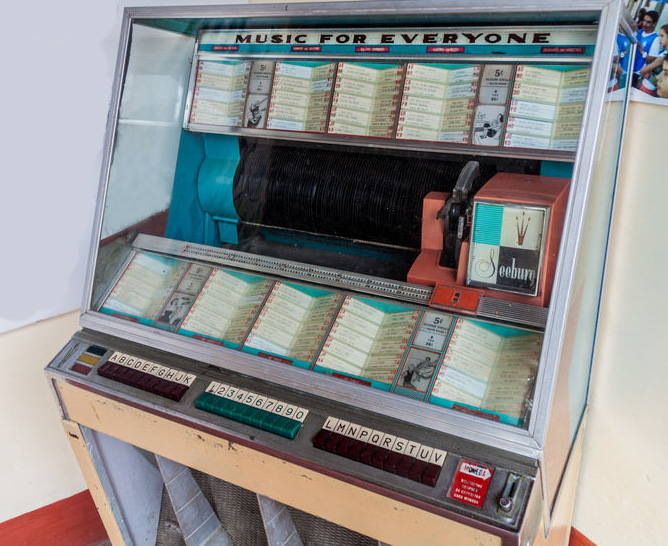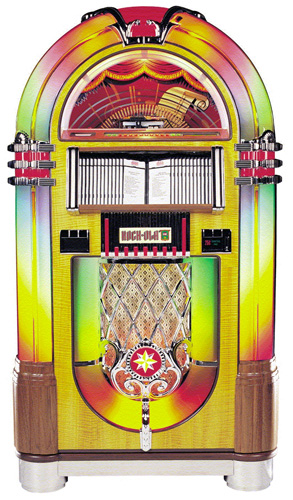
From the 1920s to the 1960s, jukeboxes electronically and mechanically advanced by increasing the capacity of their changers, better amplifiers and speakers, selectors at each table, roll around selector, and so on.
Of paramount importance was the “look” of the machine. The jukebox had to be visually exciting. The exterior design became a key to the jukebox’s success. Seeberg and Wurlitzer hired top industrial designers just when Modernism was coming into vogue.
Translucent colored plastic was starting to be widely used and was ideally suited for the illumination of the jukebox. Most manufacturers believed that the customer wanted to see the record changer work and a cabinet that lit up.
Wurlitzer dominated the post W.W. II market with its classic machine, the 1015, which featured colored arcs and floating bubblers. But in 1948, Seeberg introduced the first jukebox to handle 100 selections, the Select-O-Matic 100.
The number of records that could be played had gone from a couple of dozen records to 50 records, with both sides available for play. Until the introduction of the Select-O-Matic 100, the industry believed that 24 titles were all that were necessary for a selection of “pop” songs.
The other jukebox manufacturers quickly redeveloped their mechanisms to accommodate more records when it became obvious that the customers wanted a wider selection, and by 1956, 200 titles were available in a jukebox.

The expansion in capacity also meant that a wider variety of records could be available. Country and western and rhythm and blues could finally live in the same jukebox with Perry Como, Bing Crosby, Bill Haley and Elvis.
Unquestionably the biggest change to hit the jukebox industry came in 1948, when RCA introduced the 45. Not only did they sound better than the 78s. but they were lighter, smaller, and the center hole was large and more suitable for automated operation.
In short, it was the perfect record for a jukebox. The 45 in the jukebox of the 1950s would become the focal point of the teenager and the first line source of rock and roll.
Until television forced radio to reinvent itself, radio was the mass medium, and with few exceptions had generally ignored blues, country, and other regional or “fringe” music. The jukebox filled this void.

In the 1950s, it was the jukebox where teenagers would find the latest in music. They were doing what Teresa Brewer suggested — “put another nickel in…”– but they were selecting Chuck Berry, whose advice was to go “up to the corner and round the bend, right to the juke joint you go in. Feeling the music from head to toe, round and round, and round you go. Hail, hail, rock and roll! Deliver us from the days of old!”
Teresa didn’t know it, but Chuck was saying her days as a pop artist were numbered, as was the style of recordings she made. These machines were more than music delivery systems, their external designs were trend setters in the art deco movement and an important aspect of their popularity. They offered the latest music at a time when most of the public could not afford to buy a record, much less their own playback system.

The jukebox was key to the popular spread of country, hillbilly, rhythm and blues, and of course, the development of rock and roll music. For a generation, the jukebox at the local hang-out was the only place that some of the “hippest” and latest rock and roll could be heard.
It’s significance has declined over the last few decades but in the 1940s through the early 1960s it was an important focus for the young. Rock and roll might have been beaten down by the establishment if it had not been for the existence of jukeboxes in every bar, hamburger drive-in, bowling alley and malt shop where young people congregated.
For some of those who were there, Buddy Holly and Bill Haley will never sound better then when they were first blasting from a jukebox after inserting a nickel in a Wurlitzer. For those who weren’t there, its hard to capture it all, since it wasn’t just the jukebox that held the sound, it was where it was happening in time and place when teenagers and rock and roll were being invented.
As a 1950s Wurlitzer ad stated, “For millions, the jukebox was ‘America’s favorite nickel’s worth of fun’.”
